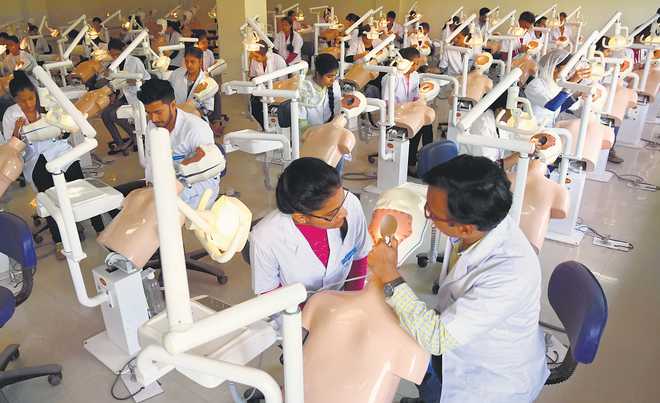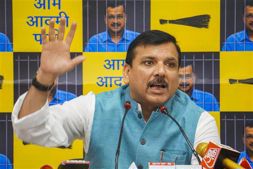
Photos: Nitin Mittal
TO replace the corrupt inspector-raj of the Medical Council of India with the new provisions in the National Medical Commission Bill is foolhardy as a majority of colleges, especially the private ones, need some kind of regulation. Currently, there are more private colleges - 221 with 24,690 MBBS seats - than government ones - 205 with 27,490 MBBS seats. In 1980, there were 112 medical colleges with only 12 in the private sector.
The NMC Bill, 2017 was introduced in the Lok Sabha last month, but was referred to the Parliamentary Standing Committee following a spate of objections by doctors all over the country. The Bill envisaged replacing the corruption-tainted Medical Council of India (MCI) by the National Medical Commission (NMC).
Going into the background of the Bill, an expert committee headed by Dr Ranjit Roy Chaudhuri had in 2015 suggested revamping medical education and practice in the country by reconfiguring the MCI's functioning. Subsequently, a NITI Aayog Committee headed by its vice-chairman Arvind Panagaria, but without a single doctor member, submitted a preliminary report that formed the basis of the Bill.
Debatable conclusions
A perusal of the report suggests that many of the conclusions on which the Bill is based upon were themselves debatable. It was suggested that district hospitals should be expanded into medical colleges and private hospitals be allowed to impart postgraduate education by utilising the large pool of doctors who have 'migrated' to the private health system. It seems that the committee did not realise that mere availability of specialists is not enough, and postgraduate training is not apprenticeship with one or more doctors. It is based on a defined curriculum with didactic lectures, seminars, bedside discussions, journal clubs and practical training.
Even now many private hospitals run the National Board of Examination Course but most of these courses have abysmal levels of training. The idea of expanding India's poorly staffed district hospitals with 'no' infrastructure into medical colleges, suggests that the committee members had little idea of the ground reality.
Laissez-faire
The Bill also proposes to facilitate privatisation of medical education. In 2016, in a departure from earlier practice, NITI Aayog removed the mandatory 'not-for-profit' clause and 'not to resort to commercialisation' precondition for getting permission to establish medical colleges. The NMC Bill actually goes one step further and dilutes the requirements for setting up medical colleges and allows the existing ones an unsupervised free hand.
Not only that, the fees of 60 per cent of the seats would also be decided by the colleges resulting in escalation of fees many times. This would deprive thousands of deserving, but poor students from pursuing a career in medicine. Instead of enhancing public investment in medical education, the NMC proposes the exact opposite. It actually legitimises profit-making in medical education and makes it a tradable commodity. One shudders to think what would be the impact of such a provision, when the nation is already rocked by unfair practices of some of Delhi's premier private hospitals.
Unholy pact
Currently, there are more private colleges than government ones. Most of them are run by trusts or societies owned by politicians. Whenever reforms in medical education were proposed earlier, they were shot down by the politician-doctor nexus. To replace the corrupt inspector-raj of the MCI with new provisions in the NMC Bill is foolhardy as a majority of colleges especially the private ones need stronger regulation. They would hoodwink the government by claiming non-existent faculty and infrastructure and even falsifying the number of tests and surgeries being conducted.
The constitution of NMC has also raised many eyebrows. A majority of its 25 members will be nominated by the government and bureaucracy. Only five part-time members will be representatives of registered medical practitioners and they too will not be a part of any of the four autonomous boards. In the past all the corruption in the MCI had emanated from private medical colleges. One would imagine that any nominated body would be prone to pressures, pulls and influences from politicians and bureaucrats.
NEET idea
There are indeed, some positive provisions in the Bill. Holding a common entrance examination (NEET) and a licentiate examination at exit is a good idea. It should be followed by a common curriculum across the country and it could lead to improved standards in medical education.
The second positive is splitting one MCI body into four independent boards for undergraduate education, postgraduate education, medical registration and medical assessment and rating to regulate each of these different aspects. However, it would have been better to add a fifth board on public health, because that remains the most neglected aspect of our health system.
The Bill has faltered on medical research as the NMC is charged to regulate medical research. This supersedes the role of agencies like ICMR and departments of Science and Technology and Biotechnology among others.
Dangerous liaisons
The most contentious issue coming out of NMC is the bridge course of six months for practitioners of AYUSH (Ayurveda, Yoga & Naturopathy, Unani, Siddha and Homoeopathy) which will enable them to practise allopathy. This is dangerous as it would put the lives of patients in danger. What an MBBS doctor learns in five-and-a-half years cannot be taught in six months to people of a different aptitude and intellectual background. This would also be an insult to genuine trained practitioners of say Ayurveda or homoeopathy. It would also have legal implications.
No doubt, the concept of the NMC is a step forward from the days of the MCI, but in its present form the Bill fails on many fronts. While the NITI Aayog committee had correctly identified what all are wrong with medical education in India, the remedies suggested by the ensuing Bill are not enough to cure them all.
THE NMC BILL
The purpose of the Bill is to modernise medical education and practice. It was introduced in the Lok Sabha on December 29, 2017 to repeal the IMC Act and dissolve the archaic Medical Council of India (MCI).
Dateline
- May 2010 -- Government superseded the IMC Act, 1956 through an ordinance for one year to reform medical education system through a newly constituted Board of Governors. Eventually, the ordinance lapsed, the IMC Act could not be amended and MCI came back to govern the medical education.
- July 2014 -- a committee under Prof Ranjit Roy Chaudhuri was constituted. In February 2015, it proposed to form a National Medical Commission (NMC) through a new Act with four autonomous boards.
- September 2015 -- The Parliamentary Standing Committee on Health & Family Welfare took up the matter, submitted a report in the Rajya Sabha in March 2016 saying, MCI "repeatedly failed on all its mandates".
- May 2016 -- While hearing a case related to dental education, the Supreme Court also reinforced sentiments expressed by the Standing Committee.
- March 2016 -- A committee headed by NITI Aayog's Vice Chairman Arvind Panagariya was constituted, which submitted the draft Bill on August 7, 2016.
Flaws in MCI
- Unable to maintain uniform education standards
- Devaluation of merit in admission to institutions
- Doubtful medical college inspections, grant of recognition or de-recognition
- Missing focus on teaching quality, training and skills
Proposed system
- NMC to regulate fees 'up to' 40% of seats in private medical institutes
- National Eligibility Cum Entrance Test (NEET) for admission
- Another exam to obtain the medical licence
- A bridge course to enable AYUSH doctors to practise allopathy
Criticisms
- Primarily a nominated body with control of politicians, bureaucrats
- Bridge course will encourage backdoor entry; it is unscientific and dangerous
- Examination for medical licence will cause unnecessary stress
- Private institutions will extort high capitation fees for 60% seats
- Vague scrutiny of private medical colleges
—The writer is the Professor of Gastroenterology, Postgraduate Institute of Medical Education and Research, Chandigarh



























